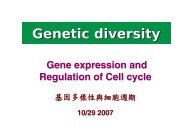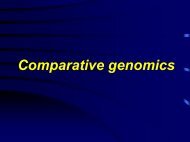Advertisement
Advertisement
Advertisement
- No tags were found...
You also want an ePaper? Increase the reach of your titles
YUMPU automatically turns print PDFs into web optimized ePapers that Google loves.
assays arrive, we firstly check the primer sequenceand quality by mass spectrometry. We then run theassays on a small number of client samples, as wellas our in-house single DNA controls and our inhousepooled DNA controls. Quite a number of SNPsin the public databases are non-polymorphic, [so] byrunning these assays on pooled DNA we can adviseour clients of expected minor allele frequencies priorto incurring genotyping charges from their fullproject. We also include negative controls to monitorfor potential contamination.On larger projects, we request that clientsleave specific plate wells empty. When they arrive,we place a combination of oligonucleotides forwhich we know the masses. When the data isbeing analyzed we check the contents of thesewells [by mass spec] to ensure there hasn't been alab mix-up.— Darryl IrwinOn the microtiter plates, among the DNA samplesof unknown genotype, we place some blanks.These are valuable to indicate any assay-specificoddities during PCR amplification or genotyping.We also use various DNA controls of knowngenotype on the plates. If the assay discriminatespoorly among individuals with different knowngenotypes, this indicates that the assay isproblematic. In the past we have also conductedresequencing of subsets of individuals and SNPs toensure that the error rate of our entire SNPgenotyping pipeline is low.— Stuart MacdonaldInitially, we tested every method (GOOD assay,Amplifluor, TaqMan, sequencing SNPlex) usingduplicate plates. With the exception of the GOODassay, we found very high repeatability.Subsequently, each plate is genotyped one timeexcept in cases where there are obvious problems.Prior to genotyping, the quality and quantity of theDNA is assessed. We have found that very lowconcentrations of DNA may affect genotyping resultsand further, it is important that the samples arehomogeneous in concentration. Then, in each plate,a number of controls are essential, includingnegative controls (water) and positive controls(previously sequenced individuals with all possiblegenotypes).— Heather McKhannResults are checked and confirmed regularly usingdifferent methods: SNPlex, pyrosequencing, TaqMan,and sequencing.— Louise NordforsFirst, checking the Hardy-Weinberg equilibrium law.Then we perform 5 percent to 10 percent reextractionfrom blood and re-typing with doubleblindcheck. For association studies, 2 percentmistyping is assumable. If more, you must discardthe marker.— Jose Luis RoyoFive to 10 percent duplicates of the total samplesused for QA. If analyzing pedigree samples, we canalso estimate the genotyping quality from thepedigree information. And 1 percent of the totalsamples are always [included] as negative controls.— Huanming Yang14 SNP Genotyping Tech Guide Genome Technology






